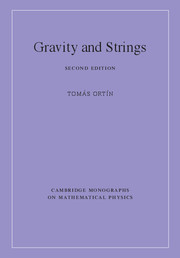Book contents
- Frontmatter
- Dedication
- Contents
- Preface to the second edition
- Preface to the first edition
- Part I Introduction to gravity and supergravity
- Part II Gravitating Point-Particles
- Part III Gravitating extended objects of string theory
- 20 String Theory
- 21 The String Effective Action And T Duality
- 22 From Eleven To Four Dimensions
- 23 The type-IIB superstring and type-II T duality
- 24 Extended objects
- 25 The extended objects of string theory
- 26 String black holes in four and five dimensions
- 27 The FGK formalism for (single, static) black holes and branes
- Appendix A Lie groups, symmetric spaces, and Yang–Mills fields
- Appendix B The irreducible, non-symmetric Riemannian spaces of special holonomy
- Appendix C Miscellanea on the symplectic group
- Appendix D Gamma matrices and spinors
- Appendix E Kähler geometry
- Appendix F Special Kähler geometry
- Appendix G Quaternionic-Kähler geometry
- Appendix H Real special geometry
- Appendix I The generic scalar manifolds of N ≥ 2, d = 4 SUEGRAs
- Appendix J Gauging isometries of non-linear σ-models
- Appendix K n-spheres
- Appendix L Palatini's identity
- Appendix M Conformal rescalings
- Appendix N Connections and curvature components
- Appendix O The harmonic operator on ℝ3 × S1
- References
- Index
21 - The String Effective Action And T Duality
from Part III - Gravitating extended objects of string theory
Published online by Cambridge University Press: 05 April 2015
- Frontmatter
- Dedication
- Contents
- Preface to the second edition
- Preface to the first edition
- Part I Introduction to gravity and supergravity
- Part II Gravitating Point-Particles
- Part III Gravitating extended objects of string theory
- 20 String Theory
- 21 The String Effective Action And T Duality
- 22 From Eleven To Four Dimensions
- 23 The type-IIB superstring and type-II T duality
- 24 Extended objects
- 25 The extended objects of string theory
- 26 String black holes in four and five dimensions
- 27 The FGK formalism for (single, static) black holes and branes
- Appendix A Lie groups, symmetric spaces, and Yang–Mills fields
- Appendix B The irreducible, non-symmetric Riemannian spaces of special holonomy
- Appendix C Miscellanea on the symplectic group
- Appendix D Gamma matrices and spinors
- Appendix E Kähler geometry
- Appendix F Special Kähler geometry
- Appendix G Quaternionic-Kähler geometry
- Appendix H Real special geometry
- Appendix I The generic scalar manifolds of N ≥ 2, d = 4 SUEGRAs
- Appendix J Gauging isometries of non-linear σ-models
- Appendix K n-spheres
- Appendix L Palatini's identity
- Appendix M Conformal rescalings
- Appendix N Connections and curvature components
- Appendix O The harmonic operator on ℝ3 × S1
- References
- Index
Summary
After Chapter 20's brief introduction to perturbative string theory and T duality we are going to discuss how one arrives at the low-energy string effective (field theory) actions, what their meaning is, and what their limits of validity are. We are going to start exploiting them to study T duality and to find Buscher's T-duality rules, which relate different curved backgrounds that are equivalent from the string-theory point of view. These rules are some of the most powerful tools of string theory.
Effective actions and background fields
The low-energy string effective action describes the low-energy dynamics of a given string theory. Here low energy means energies lower than the relevant energy scale: the string mass ms. Thus, the low-energy limit is the α′ → 0 limit, heuristically the limit in which the string length can be ignored and a theory of particles (a field theory) is recovered.
On the other hand, at low energies only the massless modes are relevant and their dynamics is described by a theory of the corresponding massless fields. The obvious way to find this field theory is to compute string amplitudes for the massless modes, take the α′ → 0 limit, and then construct a field theory that reproduces these amplitudes. In principle, the effective field theory has an expansion in powers of α′, although usually only the lowest-order terms are considered. The terms of higher order in α′ are also of higher order in derivatives. Also, string amplitudes are calculated order by order in string perturbation theory and the effective action can also be expanded in powers of the string coupling constant, which here is the exponential of the dilaton field. Again, only the lowest orders are usually considered.
Actually, for some superstring theories, it is possible to arrive at the effective theory using (super) symmetry arguments.
- Type
- Chapter
- Information
- Gravity and Strings , pp. 632 - 649Publisher: Cambridge University PressPrint publication year: 2015



